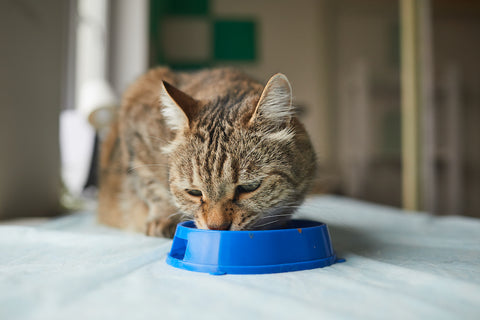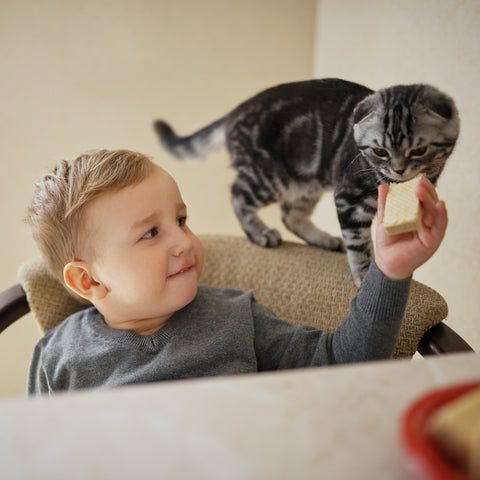How Long Can Cats Go Without Food?
In this article, we'll explore the factors that influence a cat's ability to go without food and provide insights into their unique nutritional requirements.
Understanding How Long Cats Can Safely Go Without Food

A Cat's Hunger Tolerance
Metabolism and Energy Reserves:
Cats are obligate carnivores, relying on animal-based proteins for their nutritional needs. Due to their unique physiology, they have a higher metabolic rate than some other pets.
Despite their efficient metabolism, cats can't sustain themselves for extended periods without food. Typically, a healthy cat can survive for about 3 to 7 days without eating, but this varies based on factors like age, health, and stress levels.
Water Intake:
Unlike some animals, cats may not survive as long without water as they can without food. Dehydration can set in more quickly and can have severe consequences on a cat's health.
It's important to ensure that your cat has access to fresh water at all times, especially if they are not consuming their regular meals.
Nutritional Requirements:
Cats require specific nutrients, such as taurine and arachidonic acid, which are found in animal tissues. Prolonged deprivation of these essential nutrients can have severe health consequences.
Health and Weight Status:
Cats that are overweight or have certain health issues may have different tolerances for going without food.
Consult with your veterinarian to determine your cat's specific needs based on their health status and any underlying medical conditions.
Stress and Anxiety:
Cats are sensitive to changes in their environment, and stress can significantly impact their eating habits. A stressed cat may refuse food, and extended periods of stress can lead to health issues.
Minimize stressors, provide a secure environment, and introduce changes gradually to help maintain your cat's appetite.
Behavioral Changes:
A cat's behavior can be a significant indicator of their well-being. If your cat is refusing food for an extended period, it's crucial to observe other behavioral changes, such as lethargy, hiding, or changes in litter box habits.
Dental Health:
Dental problems can affect a cat's ability to eat. Painful teeth or gums may discourage a cat from eating, emphasizing the importance of regular dental check-ups and proper oral care.
Feeding Schedule:
Cats are creatures of habit, and disruptions to their feeding schedule can cause temporary changes in eating patterns. Consistency in feeding times can help maintain a healthy appetite.
Fasting vs. Starvation:
While some cats may voluntarily fast for short periods, prolonged refusal to eat is a sign of a serious issue. Starvation can lead to hepatic lipidosis, a potentially fatal liver disorder in cats.
Feeding Strategies:
In some cases, a cat may need assistance in resuming its regular diet. Gradual reintroduction of food, offering a variety of textures and flavors, and consulting with a veterinarian can aid in the transition.
Illness and Disease:
Underlying health issues can lead to a loss of appetite. Conditions such as kidney disease, diabetes, or infections can affect a cat's overall well-being and eating habits.
Regular veterinary check-ups can help identify and address potential health concerns early on.
Emergency Situations:
If your cat refuses food for more than 24-48 hours, it's considered an emergency, and you should seek veterinary attention immediately.
Swift action is especially crucial for kittens, elderly cats, or those with pre-existing health conditions.
Cats, with their intricate needs and behaviors, present a unique set of challenges for pet owners. Understanding how long a cat can go without food is just one aspect of ensuring their well-being.
By staying attuned to your cat's needs, you can foster a happy and healthy feline companion for years to come.

Feeding Strategies: Tips for Getting Your Cat Back on Track
Getting your cat back on track with a healthy feeding routine is important for their overall well-being. Here are some tips to help you establish good feeding habits for your feline friend:
Consult Your Veterinarian:
Before making any changes to your cat's diet or feeding routine, consult with your veterinarian. They can provide guidance based on your cat's age, weight, health condition, and specific dietary needs.
Establish a Feeding Schedule:
Cats generally thrive on routine. Establish a consistent feeding schedule with set meal times. This helps regulate their appetite and can also be helpful if you need to administer medication with their food.
Portion Control:
Measure your cat's food portions to avoid overfeeding. Follow the feeding guidelines provided by the cat food manufacturer or your veterinarian. This is crucial for maintaining a healthy weight and preventing obesity-related issues.
Choose a High-Quality Cat Food:
Select a well-balanced, high-quality cat food that meets your cat's nutritional requirements. Look for options with real meat as the primary ingredient and avoid foods with excessive fillers or additives.
Consider Age and Life Stage:
Cats have different nutritional needs at various life stages. Kittens, adults, and seniors may require different types of food. Choose a cat food that is appropriate for your cat's age and life stage.
Hydration is Key:
Ensure your cat has access to fresh, clean water at all times. Wet cat food can also contribute to their overall water intake. Proper hydration is vital for kidney health.
Avoid Free Feeding:
While some cats can handle free feeding (having food available at all times), it's often not recommended, especially if your cat needs to lose weight. Controlled portions at set meal times are generally more beneficial.
Monitor Treats and Snacks:
Be mindful of the treats and snacks you give your cat. These can contribute significantly to their daily calorie intake. If you use treats, consider incorporating them into the daily calorie count and use them sparingly.
Introduce Puzzle Feeders:
To add mental stimulation and slow down eating, consider using puzzle feeders or food-dispensing toys. This engages your cat's natural hunting instincts and can be particularly helpful for indoor cats.
Gradual Changes:
If you need to switch your cat to a new food or adjust their feeding routine, do so gradually. Sudden changes can lead to digestive upset. Mix the new food with the old in increasing proportions over several days.
Remember that individual cats may have unique needs, so it's essential to tailor these tips to your cat's specific circumstances. Regular veterinary check-ups will also help ensure that your cat's diet remains suitable for their health and lifestyle.
Leave a comment
